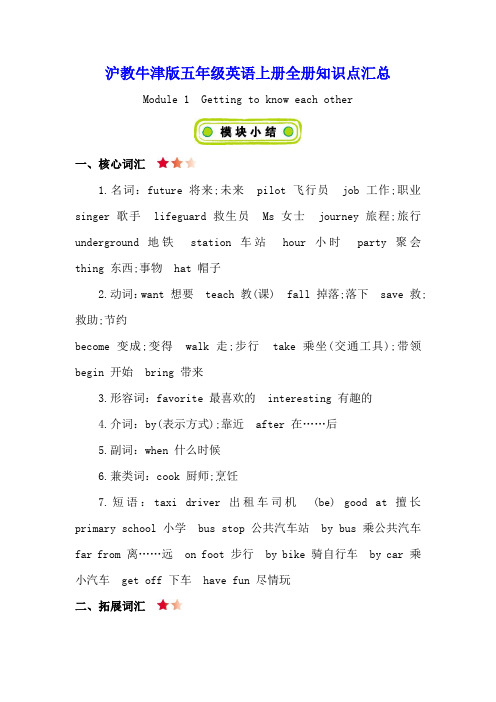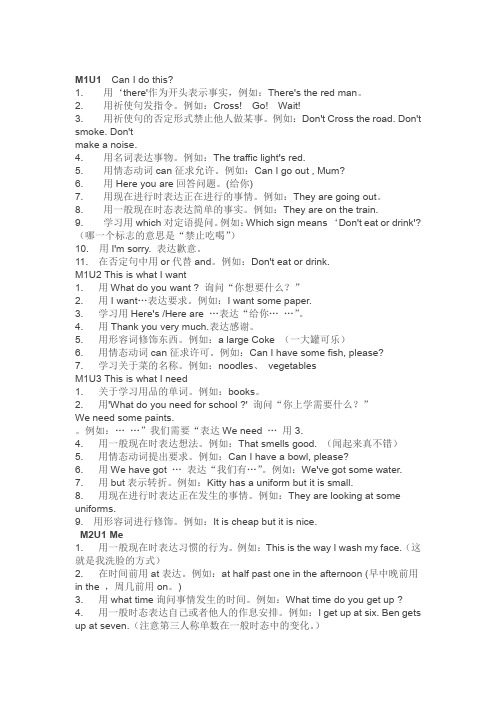牛津英语上海版五年级上册知识点
- 格式:docx
- 大小:16.84 KB
- 文档页数:10

M1U1 Can I do this?1. 用‘there’作为开头表示事实,例如:There’s the red man。
2。
用祈使句发指令。
例如:Cross! Go! Wait!3. 用祈使句的否定形式禁止他人做某事。
例如:Don’t Cross the road。
Don't smoke。
Don’t make a noise.4。
用名词表达事物。
例如:The traffic light’s red.5。
用情态动词can征求允许。
例如:Can I go out , Mum?6. 用Here you are回答问题。
(给你)7. 用现在进行时表达正在进行的事情。
例如:They are going out。
8。
用一般现在时态表达简单的事实。
例如:They are on the train。
9. 学习用which对定语提问。
例如:Which sign means ‘Don’t eat or drink’?(哪一个标志的意思是“禁止吃喝”)10. 用I’m sorry. 表达歉意。
11. 在否定句中用or代替and。
例如:Don’t eat or drink.M1U2 This is what I want1. 用What do you want ? 询问“你想要什么?”2. 用I want…表达要求。
例如:I want some paper.3. 学习用Here’s /Here are …表达“给你… …”。
4。
用Thank you very much.表达感谢。
5。
用形容词修饰东西。
例如:a large Coke (一大罐可乐)6。
用情态动词can征求许可。
例如:Can I have some fish,please?7。
学习关于菜的名称。
例如:noodles、vegetablesM1U3 This is what I need1。
关于学习用品的单词。
例如:books.2。
用’What do you need for school ?' 询问“你上学需要什么?"3。

沪教牛津版五年级英语上册全册知识点汇总Module 1 Getting to know each other一、核心词汇1.名词:future 将来;未来pilot 飞行员job 工作;职业singer 歌手lifeguard 救生员Ms 女士journey 旅程;旅行underground 地铁station 车站hour 小时party 聚会thing 东西;事物hat 帽子2.动词:want 想要teach 教(课) fall 掉落;落下save 救;救助;节约become 变成;变得walk 走;步行take 乘坐(交通工具);带领begin 开始bring 带来3.形容词:favorite 最喜欢的interesting 有趣的4.介词:by(表示方式);靠近after 在……后5.副词:when 什么时候6.兼类词:cook 厨师;烹饪7.短语:taxi driver 出租车司机(be) good at 擅长primary school 小学bus stop 公共汽车站by bus 乘公共汽车far from 离……远on foot 步行by bike 骑自行车by car 乘小汽车get off 下车have fun 尽情玩二、拓展词汇1.名词:doctor 医生teacher 老师sky 天空subject 科目2.月份名词:January (Jan.) 一月February(Feb.) 二月March(Mar.) 三月April(Apr.) 四月May 五月June(Jun.) 六月July(Jul.) 七月August(Aug.) 八月September(Sept.) 九月October(Oct.) 十月November(Nov.) 十一月December(Dec.) 十二月3.动词:help 帮助4.短语:fly a plane 驾驶飞机be afraid of 害怕三、核心句型1.—What do you want to be? 你想要成为什么?—I want to be a pilot. 我想要成为一名飞行员。

M1U1 Can I do this?1. 用‘there'作为开头表示事实,例如:There's the red man。
2. 用祈使句发指令。
例如:Cross! Go! Wait!3. 用祈使句的否定形式禁止他人做某事。
例如:Don't Cross the road. Don't smoke. Don'tmake a noise.4. 用名词表达事物。
例如:The traffic light's red.5. 用情态动词can征求允许。
例如:Can I go out , Mum?6. 用Here you are回答问题。
(给你)7. 用现在进行时表达正在进行的事情。
例如:They are going out。
8. 用一般现在时态表达简单的事实。
例如:They are on the train.9. 学习用which对定语提问。
例如:Which sign means ‘Don't eat or drink'? (哪一个标志的意思是“禁止吃喝”)10. 用I'm sorry. 表达歉意。
11. 在否定句中用or代替and。
例如:Don't eat or drink.M1U2 This is what I want1. 用What do you want ? 询问“你想要什么?”2. 用I want…表达要求。
例如:I want some paper.3. 学习用Here's /Here are …表达“给你……”。
4. 用Thank you very much.表达感谢。
5. 用形容词修饰东西。
例如:a large Coke (一大罐可乐)6. 用情态动词can征求许可。
例如:Can I have some fish, please?7. 学习关于菜的名称。
例如:noodles、vegetablesM1U3 This is what I need1. 关于学习用品的单词。

沪教牛津英语五年级上册知识点归纳1.用‘ there作’开表示事 ,例如: There ’ s the red man。
2.用祈使句指令。
例如: Cross! Go! Wait!3.用祈使句的否定形式禁止他人做某事。
例如:Don’ t Cross the road. Don’ t smoke. Don’make a noise.4.用名表达事物。
例如: The traffic light’ s red.5.用情 can 征求允。
例如: Can I go out , Mum?6.用 Here you are 回答。
(你 )7.用在行表达正在行的事情。
例如:They are going out 。
8.用一般在表达的事。
例如:They are on the train.9.学用 which 定提。
例如: Which sign means ‘ Don’ t eat or drink’?(哪一个志的意思是“禁止吃喝”)10.用 I ’ m sorry表.达歉意。
11.在否定句中用 or 代替 and 。
例如: Don’ t eat or drink.M1U2 This is what I want1.用 What do you want ?“你想要什么?”2.用 I want ⋯表达要求。
例如: I want some paper.3.学用 Here’ s /Here are 表⋯达“ 你⋯ ⋯”。
4.用 Thank you very much. 表达感。
5.用形容修西。
例如: a large Coke (一大罐可)6.用情 can 征求可。
例如: Can I have some fish, please?7.学关于菜的名称。
例如: noodles 、 vegetablesM1U3 This is what I need1.关于学用品的。
例如: books 。
2.用’ What do you need for school ? ’“你上学需要什么?”3.用 We need ⋯表达“我需要⋯ ⋯”。

M1U1第2页get to know you 了解你an ‘orange’ party 一个橘色派对come to my birthday party 来参加我的生日聚会on Sunday 在周日on the ninth of September = on September the ninth 在九月九号at two o’clock in the afternoon = at 2:00 p.m. 在下午两点bring or wear some orange things to the party 带或穿一些橘黄色的东西来参加聚会my favourite colour 我最喜欢的的颜色be moved 很感动的That sounds interesting/ funny. 听起来很有趣/滑稽。
I can’t wait. 我等不及了。
give sb a big surprise 给某人一个惊喜be surprised 很惊讶的第3页1. 单词:一月到十二月in January, February, March, April, May, June, July, August, September, October, November, December2. 序数词:第一到第三十一见书序数词前+the 例如:the first第4页at Peter’s birthday party 在Peter的生日聚会上 a pair of orange trousers 一条橘色裤子a picture of you /him/her 一张你的图片make your own(invitaion) 做你的请柬have some fun = have a good time = enjoy ourselves 玩得开心make a birthday invitation 做一张生日请柬invite sb to the party 邀请某人去聚会live in Room 301 住在301室live on Yongqing Road 住在永清路live at Room 301, Building 9, 58 Yongqing Road 住在永清路58号9号楼301室近义词(同义词):begin – start interesting – funny present – gift复数:party – parties Sunday – Sundays第5页Tommy’s birthday present Tommy的生日礼物be busy doing sth. 忙于做某事the next morning 第二天早上 a smart new hat 一顶漂亮的新帽子a hat maker 一个做帽子的人be tired of sweets 厌倦糖果be late for school 上学迟到反义词:come – go bring – take interesting – boring busy – free sad – happy late – early next – last new – old easy – hard / difficult第6页drill 钻孔least 最少at least 至少leave 离开leave home 离开家last but not least 最后但也是最重要的(用于作文最后一段)句型1. When does the first class begin? It begins at 8:30.(begin 是动词,不要与is连用,三单动词加“s”。

沪教版(上海)牛津英语5A五年级上册知识点汇总Module1Unit1一,核心词汇1.first第一 2.second第二第二 3.third第三 4.fourth 第四第四 5.fifith第五6.sixth第六7.party派对,聚会 8.begain开始 9.bring 带来10.wear穿着11.favourite最喜欢的二,词组1. at Peter’s birthday party在Peter的生日聚会上 2. on the 19th of September在9月19日on Sunday在周日 4在晚上.at two o’clock在两点 5. in the afternoon在下午 6. at night7. sb. be tired某人很累某人很累 8. my favourite color我最喜欢的颜色 9. That sounds interesting.那听上去有趣10. I can’t wait! 我等不及了!欢迎来我的派我等不及了! 11. Happy Birthday! 生日快乐 12. Welcome to my party. 一条橙色的裤子 14. make a birthday invitation制作一张生日请帖对 13. a pair of orange trousers15. make a hat制作一顶帽子 16. have some fun过得高兴 17. birthday present生日礼物三,词汇解释1.bring,take,carry辨析bring是指把人或物从别处带到说话人所在的地方。
例如:Bring me some water, please.请给我取点水来。
carry及物动词,“搬运,运送”,一般是指搬运较重的物品。
例如:carry a box on one’s shoulder扛着箱子 carry a baby on one’s back背着孩子“携带,带”例如:Almost every teacher carries a watch.我身边不带差不多每位教师都带着一只表。
致易教育个性化指导教课方案五年级上册课本知识点梳理Module1 Unit1一,核心词汇1.first 第一2.second第二3.third 第三4.fourth 第四5.fifith 第五6.sixth 第六7.party 派对,聚会8.begain 开始9.bring 带来 10.wear 穿着 11.favourite 最喜欢的二,词组1.at Peter’ s birthday在partyPeter的寿辰聚会上2.on the 19th of September在 9 月 19 日3. on Sunday在周日4.at two o’clock在两点5. in the afternoon在下午6. at night 在夜晚7. sb. be tired某人很累8. my favourite color 我最喜欢的颜色9. That sounds interesting那.听上去幽默10. I can’t wait!我等不及了!11. Happy Birthday! 寿辰快乐12.Welcome to my party. 欢迎来我的派对13.a pair of orange trousers一条橙色的裤子14.make a birthday invitation 制作一张寿辰请帖15. make a hat制作一顶帽子16. have some fun过得快乐17.birthday present寿辰礼物三,词汇讲解1.bring,take,carry 辨析bring 是指把人或物从别处带到说话人所在的地方。
比方:Bring me some water, please请.给我取点水来。
carry 及物动词,“搬运,运送”,一般是指搬运较重的物品。
比方:carry a box on one’ s shoulder扛着箱子carry a baby on one’背s着back孩子“携带,带”比方:Almost every teacher carries a watch差.不多每位教师都带着一只表。
Unit 1 My future知识点总结一、必会词汇want 想要pilot 飞行员teach教(课)cook厨师;烹饪taxi driver出租车司机job工作;职业become变成;变得二、拓展词汇future 将来;未来singer歌手fall掉落;落下save救;救助;节约(be)good at 擅长三、核心短语fly a plane 驾驶飞机help people 帮助人们teach English教英语cook nice food烹饪美味的食物四、字母组合sk发音的单词: ask desk mask五、核心句型1-What do you want to be?你想要成为什么?-I want to be a pilot. 我想要成为一名飞行员。
解读:这是询问某人理想的句型及其回答。
当主语是第三人称单数时,谓语动词要做相应变化。
举一反三:-What does he/she want to be?他/她想要成为什么?-He/She wants to be a teacher他/她想要成为一名老师。
2.I want to fly a plane in the sky.我想要在天空中驾驶飞机。
解读:这是描述某人想要做某事的句型。
举一反三:I want to have a picnic.我想去野餐。
3.be good at 用法be good at后跟名词或者动名词,表示“擅长(做)某事”。
She is good at English她擅长英语。
Tom is good at swimming.汤姆擅长游泳。
Unit 2 Going to school 知识点总结一、必会词汇by(表示方式);靠近walk 走;步行Ms女士underground 地铁take乘坐(交通工具);带领after在……后hour小时二、拓展词汇journey旅程;旅行station 车站三、核心短语primary school 小学bus stop 公共汽车站by bus乘公共汽车far from离……远on foot步行by bike骑自行车by car乘小汽车get off下车四字母组合sp发音的单词:wasp crisp五、核心句型1-Howdo you come to school?你是怎么来学校的?-I come to school on foot.我步行来学校。
沪教牛津英语五年级上册知识点归纳作为开头表示事实;例如:There’s the red man。
1. 用‘there’2. 用祈使句发指令。
例如:Cross! Go! Wait!3. 用祈使句的否定形式禁止他人做某事。
例如:Don’t Cross the road. Don’t smoke. Don’make a noise.4. 用名词表达事物。
例如:The traffic light’s red.5. 用情态动词can征求允许。
例如:Can I go out , Mum?6. 用Here you are回答问题。
(给你)7. 用现在进行时表达正在进行的事情。
例如:They are going out。
8. 用一般现在时态表达简单的事实。
例如:They are on the train.9. 学习用which对定语提问。
例如:Which sign means ‘Don’t eat or drink’?(哪一个标志的意思是“禁止吃喝”)10. 用I’m sorry. 表达歉意。
11. 在否定句中用or代替and。
例如:Don’t eat or drink.M1U2 This is what I want1. 用What do you want ? 询问“你想要什么?”2. 用I want…表达要求。
例如:I want some paper.表达“给你……”。
3. 学习用Here’s /Here are …4. 用Thank you very much.表达感谢。
5. 用形容词修饰东西。
例如: a large Coke (一大罐可乐)6. 用情态动词can征求许可。
例如:Can I have some fish, please?7. 学习关于菜的名称。
例如:noodles、vegetablesM1U3 This is what I need1. 关于学习用品的单词。
例如:books。
询问“你上学需要什么?”2. 用’What do you need for school ?’ 3. 用We need … 表达“我们需要……”。
Module1 Getting to know you
Unit1 My birthday
生词:
first second third fourth fifth sixth
音标:
When is your
birthday?
It’s on
the...of
January/Febru
ary/March/Apr
il/May/June/J
uly/August/Se
ptember/Octob er/
November/December.
Unit2 My way to school 生词:
taxi underground zebra crossing traffic lights pavement 音标:
语法:
How do you
come to
school?
I
come
to
school...
Unit3 My future 生词:
worker pilot farmer cook shop assistant
音标:
What do
you want
to be?
I want to
be
a/an...
Module2 Me,my family and friends
Unit1 Grandparents
生词:
write an e-mail go shopping play chess
语法:
How often...
Unit2 Friends 生词:
Same different both all 音标:
语法: sb.
both...(do)...
Unit3
Moving home 生词:
West north
east south 音标:
Because...
Module3
Places and
activities
Unit1 Around the city
生词:
Hotel bank hospital bakery museum cinema
音标:
语法:
How do I get to...,please?
Walk along...
Unit2 Buying new clothes
生词:
button zip pocket
音标:
语法:
Which ... Do you like, the ... One or the ... One?
I like the ... One.
Unit3 Seeing the doctor
生词:
fever toothache cough cold
音标:
语法:
What should I do?
You should...
Module4 The nature word Unit1 Water
生词:
first next then finally 音标:
语法:
First/Next/Then/Final ly,...
Unit2 wind 生词:
gently stronger slowly quickly 音标:
语法: It is blowing
gently.
Unit3 Fire 生词:
Don ’t smoke Don ’t start
campfires Don ’t play near fires Don ’t play with matches 音标:
法:We must /mus tn’
t...。